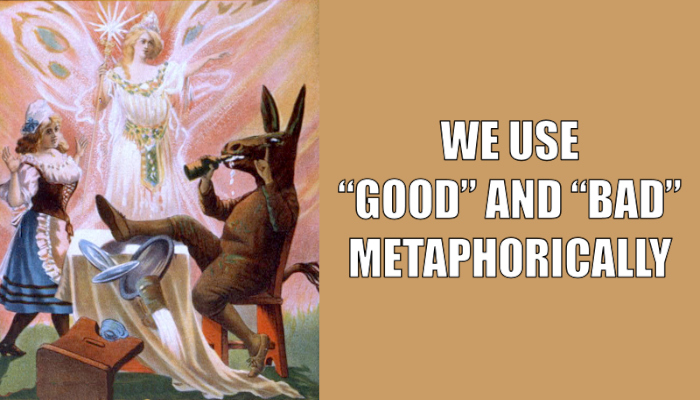
The second post in a series on metaphor
Last post, we described how humans use metaphor to transfer the properties of one thing to another. Today we discuss the value-judgments that we make with respect to those properties.
Metaphor works because we all share one thing: the human condition. George Lakoff and Mark Johnson explain how.
“We are physical beings, bounded and set off from the rest of the world by the surface of our skins, and experience the rest of the world as outside us. Each of us is a container, with a bounding surface and an in-out orientation onto other physical objects that are bounded by their surfaces. Thus, we also view them as containers with an inside and an outside.”1
Humans are autonomous beings who wonder through the world collecting experiences as we interact with physical phenomena. We learn that the sun comes up every morning and sets every night. We go to bed at night and wake up in the morning. When we get out of bed, gravity holds our feet to the ground and the friction between our feet and the floor allows us to propel forward rather than slipping and falling. We breathe in a mixture of nitrogen and oxygen and expel carbon dioxide. When we touch a hot stove we pull away quickly, yet when we experience the embrace of a warm hug, we pull closer.
We rely on our five senses to navigate through this world through our senses of sight, sound, taste, touch, smell. All rely on measuring differences–in light (sight); sound pressure (hearing), flavor (taste), hardness, texture, temperature, weight (touch), and fragrances (smell). Because our senses are built upon determining differences, we make value-judgments and categorize some as pleasant (good) and others as unpleasant (bad).
Sight: We need light to see, thus more light is perceived as better than less light. Since we prefer brightly lit objects to dimly lit ones, we categorize the former as good and the latter as bad. For example, take a look at the following metaphoric properties based on the sense of sight.
- Bright hope
- Dim despair
- Sharp argument
- Fuzzy logic
Sound: Our ears discern differences in sound pressures–the larger difference, the louder the sound. Since loud sounds startle while soft sounds soothe, we associate loud with bad and soft with good. But, there’s some additional subtlety here because not all soft sounds are pleasant. Certain musical notes played simultaneously clash, while others form beautiful harmonies. Consider the following metaphoric properties based on the sense of hearing.
- Soft-spoken words
- Loud-mouthed diatribe
- Harmonious voices
- Discordant views
Touch: Our sense of touch helps determine differences in texture, hardness, temperature, and weight. We associate those that bring pleasure as good (smooth, soft, warm, light), and those that don’t (jagged, solid, hot/cold, heavy) as bad.
- Rough patch
- Smooth sailing
- Hard edge
- Soft landing
- Warm hands
- Cold heart
- Heavy response
- Light touch
Taste: Our sense of taste helps us discern five different flavors: sweet, sour, bitter, salty, and savory. We consider some to be more pleasurable (good) than others (bad), like:
- Sweet melody
- Sour note
- Bitter defeat
- Salty language
- Savory victory
Smell: Our noses can discern trillions of different scents–some that we enjoy (good) and others that we don’t (bad), as in:
- Fishy concept
- Sniff test
- Love stinks (yeah, yeah)
We’re autonomous beings, wandering through the same physical environment with the help of our five senses. We associate properties with the things that we encounter and simultaneously attach the concept of good and bad to them. Finally, we convey new meaning to other autonomous beings by transferring these properties and value judgments through metaphor.
Notes:
Photo Credit: U.S. Lithograph Co, and Chas. H Yale. Chas. H. Yale’s everlasting Devil’s auction. , ca. 1904. Cincinnati ; New York: U.S. Lithograph Co. Photograph. https://www.loc.gov/item/2014635390/.
1. George Lakoff and Mark Johnson, Metaphors We Live By (University of Chicago Press, 2003) Kindle e-book location 521/4362